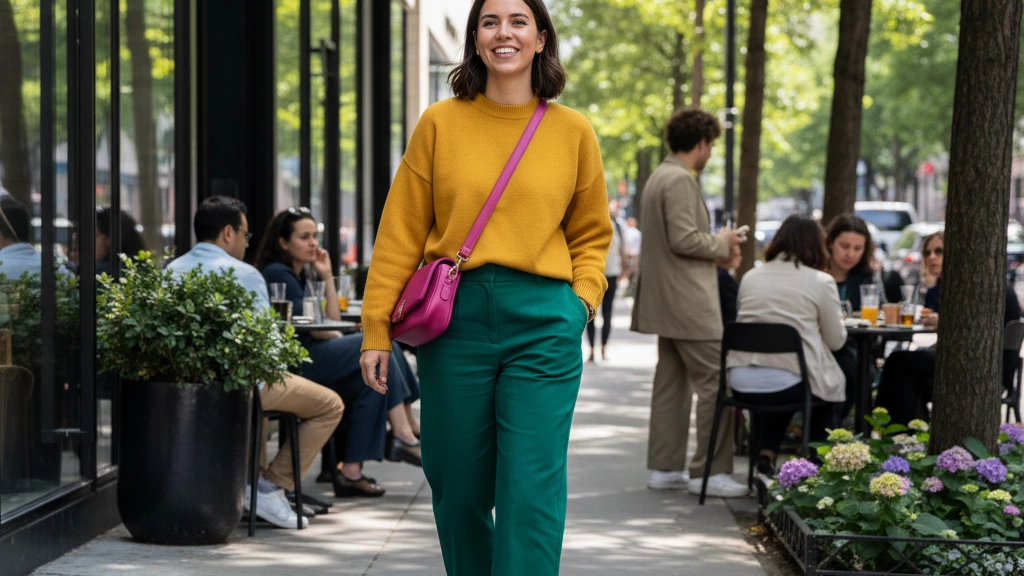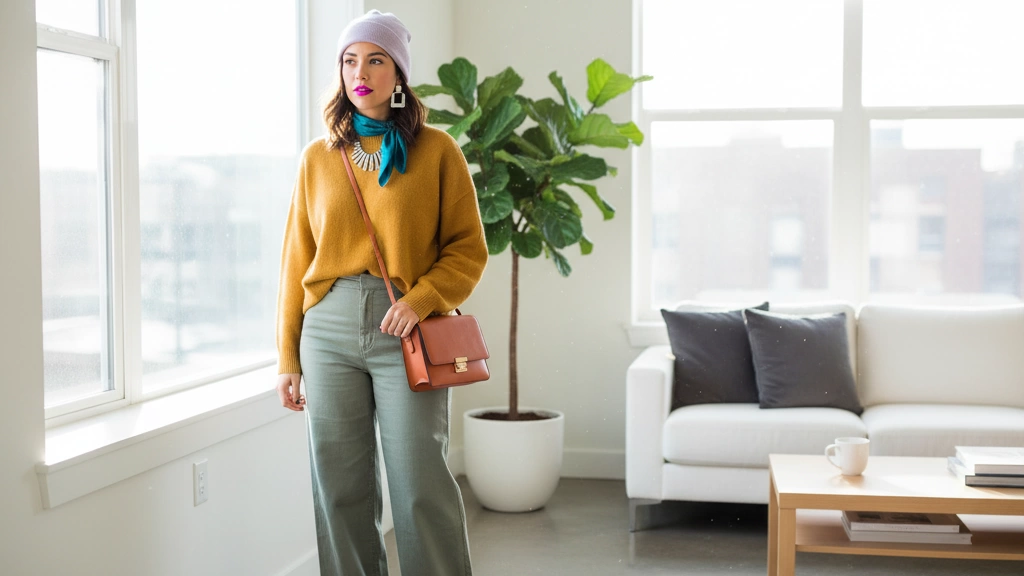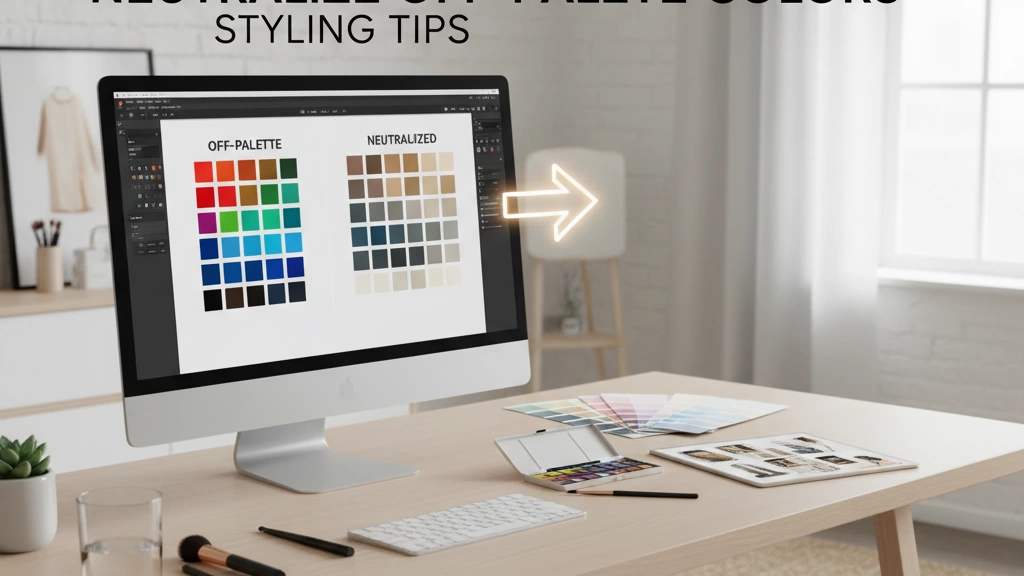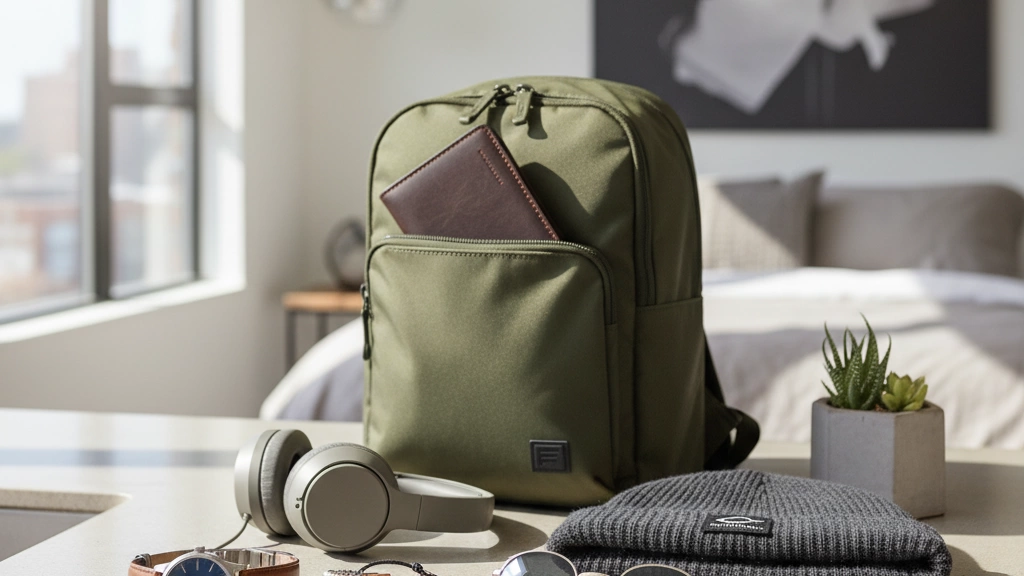Understand Why a Colour “Clashes” With You
Before you give up on that gorgeous jewel tone or pastel shade, it helps to know why it feels off. Here’s the secret: every colour has three key dimensions that affect how it works with your natural colouring.
The three dimensions to know:
Temperature: Is it warm (think sunny yellows, fiery reds) or cool (icy blues, berry purples)?
Value: How light or dark is the colour? Imagine a spectrum from pale pastels to deep charcoals.
Chroma: How intense or muted is it? Bright, clear shades versus soft, dusty tones.
Often, a “clashing” colour isn’t the entire shade—you might just be off on one of these dimensions. For example, a Soft Summer might love pink but find neon fuchsia overwhelming because it’s too bright (high chroma), not because pink itself is off-limits.
Quick self-check:
Grab your favourite “problem” colour and compare it against your palette in these ways:
- Is it warmer or cooler than your usual tones?
- Is it lighter or darker than your best colours?
- Is it more vibrant or muted than what suits you?
Figuring out which dimension trips you up is the first step to bending the rules without losing that beloved shade. Because trust me, giving up emerald green when you’re a Soft Summer feels like grief—and with a little tweak, you don’t have to!
The Golden Ratio: 70–80% On-Palette, 20–30% Off-Palette

When wearing colours outside your season, the best way to make it work is by following the 70–80% on-palette, 20–30% off-palette rule. This means most of your outfit should stick to your best colours, while a smaller portion can include those off-palette hues you love but aren’t your strongest match.
This balance keeps your look harmonious without losing your personal style. For example, actress Emma Stone often mixes her seasonal palette with a pop of unexpected colour—a predominantly soft, muted base with a bold splash of red on her shoes or clutch. Similarly, Zendaya nails this by wearing mostly on-palette tones but adding a striking off-palette accessory or a statement piece that complements her overall look without overwhelming it.
By applying this golden ratio, you allow yourself to enjoy your favourite colours without clashing or feeling out of sync. It’s a smart way to break seasonal colour rules while staying polished and wearable.
For styling tips on incorporating off-palette accessories seamlessly, check out our guide on finding your accessory style.
Placement Is Everything – Where to Put the “Wrong” Colour

When you want to wear colours outside your season or off-palette colours, where you place these shades can make all the difference. The general rule? Keep the “wrong” colour as far from your face as possible.
-
Furthest from the face: Think bags, shoes, trousers, or skirts. These pieces allow you to enjoy your favourite off-palette colours without them clashing directly with your complexion.
Mid-distance: Jackets, cardigans, or belts sit a bit closer but still don’t compete with your natural colouring as much. This placement can work well if you want to introduce a pop of that colour without overwhelming the face.
Closest to the face only if…
This is the tricky part. You can wear an off-palette colour near your face if you’ve neutralised it (more on that later), or if it’s a toned-down or adapted version that blends better with your undertones. Exceptions include makeup or scarves that help soften the contrast.
By mastering placement, you get to incorporate those beloved but challenging colours in a way that feels natural. For more ideas on using accessories to pull these looks together, check out this detailed guide on using accessories for off-palette colours.
Neutralise the Off-Palette Colour

One of the easiest ways to wear colours that don’t suit you is to neutralise them with your best neutrals. Think camel, ivory, charcoal, taupe, or navy—these shades act like a buffer, toning down the clash so the off-palette colour doesn’t compete with your natural tones. For example, if you love a bold orange but it’s not in your palette, layer it with a navy jacket or camel cardigan to soften the overall look.
Another great trick is using metallic accessories as bridges between your off-palette colour and your natural palette. Gold, silver, or rose gold jewelry can create a subtle transition, helping the colour feel more cohesive without overpowering your style. If you want specific ideas on pairing metals with colours, check out this guide on how to choose the right jewelry for your outfits and color.
Finally, adding a scarf, collar, or any framing piece in your seasonal palette around your neckline can pull the look together. This subtle frame brings the focus back to the colours that suit you best, while still letting you enjoy your favourite, less flattering hues elsewhere. It’s about balance—making the “wrong” colour work by cushioning it with the “right” ones.
Lower the Intensity or Shift the Undertone Slightly
If a colour you love feels too harsh or just “not you,” try wearing a toned-down version instead. For instance, Soft Summers usually struggle with bright fuchsias, but a dusty rose can give you that same vibe in a gentler way. Similarly, instead of a bright true red, going for a deeper burgundy or a softer wine shade works better if you’re someone who can’t pull off stark colours.
Another trick is to shift the undertone slightly. Warm up a cool blue with a hint of grey or soften a bright yellow by leaning into a mustard tone. These subtle adjustments help colours blend with your natural tones more seamlessly without giving up your favourites.
Here are some quick swatch comparisons that might help:
- Bright fuchsia → Dusty rose
- True red → Burgundy or brick red
- Neon orange → Muted terracotta
- Clear turquoise → Soft teal or muted aqua
This approach of lowering chroma or tweaking undertones gives you a way to break seasonal colour rules without losing harmony in your outfits.
By choosing these gentler versions, you can still incorporate off-palette colours into your wardrobe in a flattering way that feels like you.
Use Pattern & Print to Your Advantage
One of the easiest ways to wear colours you love but aren’t your best is through patterns and prints. When your favourite off-palette colour appears as part of a print—especially in small amounts—it feels more intentional and less “clashing.” Aim for small-scale prints where your loved colour makes up less than 30% of the pattern. This subtle presence avoids overwhelming your natural palette.
Floral, animal, and abstract prints are perfect because they often mix multiple colours, including some from your season plus your off-palette favourite. This blend helps bridge the gap between what suits you and what you want to wear.
For example, if you’re a Soft Summer but adore a bright coral, look for a floral print where that coral is paired with dusty blues and muted greys. This keeps the look balanced and wearable without sacrificing your style.
Try layering patterned pieces under neutral jackets or over basics to soften any colour conflicts. This method also allows you to explore off-palette colours without fully committing, making it an excellent strategy to break seasonal colour rules with confidence.
Makeup & Hair as Buffers

Using makeup and hair colour strategically can help soften the impact of colours that don’t naturally suit you near your face. Lipstick or blush in shades that complement your off-palette colour can create a subtle balance, making the difficult shade feel more harmonious. For example, if you’re a Soft Summer struggling with a bright coral top, a muted rose lip or soft plum blush can act as a bridge, easing the contrast.
Similarly, adjusting your hair colour slightly—like adding warm or cool highlights—can help “absorb” an off-palette tone in your outfit. A cool-toned ash blonde might neutralize a neon yellow garment, while warm caramel balayage can soften an otherwise clashing icy blue.
Product examples by season:
- Soft Summers: Dusty rose lipsticks like MAC’s “Twig” or blushes with mauve undertones.
- Bright Winters: Bold berry lipstick shades and cool pink blushes help with bright orange or mustard pieces.
- Dark Autumns: Warm brick reds or terracotta lips paired with golden highlights can balance pastel blues or pinks near the face.
Using makeup and hair in this way is a subtle, effective trick to incorporate colours outside your season without overwhelming your natural tones.
For more tips on accessorizing with colour, check out our guide on how to add a pop of colour.
The Magic of Denim, Black and White as Universal Mediators
Medium-wash denim is a game-changer when it comes to wearing colours that aren’t your best. Its neutral yet textured look makes it incredibly versatile, allowing almost any off-palette colour to feel more natural and balanced. Whether it’s a bold neon or a muted pastel, pairing it with denim grounds the outfit without overwhelming your natural tone.
Black and white also serve as excellent anchors for off-palette colours. Wearing black can add sophistication and depth, making a tricky colour look intentional and polished rather than clashing. White, on the other hand, offers freshness and contrast, brightening an off-palette shade and keeping your look crisp. Both can act as simple yet powerful “buffers” that help you experiment confidently.
By integrating these universal mediators into your outfit, you create a solid foundation that makes wearing your favourite colours—even when they break seasonal colour rules—much easier. For more ideas on incorporating complementary accessories that tie your look together, check out this guide to storing your necklaces and bracelets, which offers tips on accessorising to elevate any outfit.
Accessories-Only Rule for “Impossible” Colours
Some colours just seem impossible to wear—think neon, pure orange, or bubblegum pink. These shades often don’t fit into your palette or clash heavily with your natural tones. The good news? You can still enjoy them, but keep them in accessories only.
Why? Accessories like bags, sunglasses, nails, and earrings give you total freedom—no strict rules apply here. They let you add a fun pop of colour without overwhelming your overall look or skin tone. For example:
- Neon sunglasses create a cool edge without dominating your face.
- A bright orange handbag can add energy to a muted outfit.
- Bubblegum pink nails or earrings bring a playful touch without being a main colour.
This approach makes “impossible” colours easy to wear while staying stylish and balanced. If you want to push boundaries, check out tips on how to match your earrings for complementary off-palette colours and mixing metals confidently.
In short, when a colour feels too much to wear in clothes, let your accessories carry it instead. It’s the safest, most flexible way to break seasonal colour rules without regret.
Seasonal Exceptions and Context
Sometimes, the rules about wearing colours outside your season can — and should — bend depending on where you are or what you’re doing. For example, bright or off-palette colours can feel perfectly at home on vacation or at the beach, where casual, relaxed vibes welcome more playful tones. In contrast, the office usually calls for a more polished, on-palette approach, keeping off-palette colours subtle or in small doses.
Evening events and parties are another great excuse to break seasonal colour rules. Dim lighting, especially candlelight, softens harsh contrasts and “forgives” colours that might normally clash in daylight. This means you can wear that daring shade close to your face without it overwhelming you.
When figuring out how to wear colours that don’t suit you in these different contexts, consider:
- Vacation/beach: Embrace your favourite off-palette colours fully—think swimsuits, cover-ups, or relaxed separates.
- Office: Limit off-palette colours to accessories or accents, ensuring your core wardrobe remains harmonious.
- Evening: Use lighting tricks to your advantage, choosing richer or deeper versions of your favourite colours.
This approach lets you enjoy your beloved hues while adapting to context and setting, creating flexibility in your wardrobe without sacrificing your overall colour harmony.
Real Reader & Celebrity Case Studies
Seeing real examples helps when you want to wear colours outside your season but still look confident. Let’s look at some inspiring case studies that show how people—and celebrities—break the usual rules with flair.
Soft Autumn Who Loves Barbie Pink
Soft Autumns typically avoid bright, cool pinks like Barbie pink because their palette is warm and muted. Yet, a well-known actress with a Soft Autumn palette pairs Barbie pink with camel or olive tones—classic autumn neutrals—to neutralise the brightness and keep the overall look balanced. Notice how the pink never touches her face directly; it appears in accessories or skirts, making it possible to wear a favourite but off-palette colour in small doses without clashing.
Bright Winter Obsessed with Mustard
Mustard is usually too warm and muted for Bright Winters, who shine in clear, icy shades. However, a famous Bright Winter singer styles mustard as a statement jacket layered over stark white and navy basics. By keeping 70–80% of the outfit on-palette and using black or navy as grounding colours, she breaks the rule tastefully. This is a perfect example of the 80/20 colour palette rule in action, proving how off-palette colours work when balanced right. See some similar layering inspiration in top autumn transitional jackets.
Dark Autumn and Baby Blue – Before & After Outfits
Baby blue is generally too cool and light for Dark Autumn, clashing with their rich, deep, warm tones. A notable Dark Autumn influencer shared side-by-side outfits—one wearing baby blue close to the face, which looked washed out, and another where a baby blue handbag and scarf added just enough pop from a distance. The after look is layered with charcoal and warm camel, using the “placement is everything” rule to keep baby blue from dominating. The trick? Keep the baby blue as a supporting player, not a lead. For similar ideas, check out some celebrity style inspiration with versatile accessories.
These real-life and celebrity cases show that loving a colour not in your palette doesn’t mean you have to give it up. With smart placement, layering, and a good ratio of on- to off-palette colours, you can wear what you love without sacrificing harmony.
Your “Love It” Capsule – Build a Mini Wardrobe of Exceptions
Sometimes, you just can’t give up a colour that isn’t in your usual palette. That’s where a “Love It” capsule wardrobe comes in—a small, curated collection of pieces in those off-palette shades you adore. Stick to the 5-piece rule to keep it manageable and stylish without overwhelming your overall look.
Here’s how to build it:
- Choose 3 key items in your favourite off-palette colours. These could be tops, dresses, or jackets that you genuinely love wearing.
- Add 2 versatile neutrals or classic pieces that help ground those colours and make mixing easier.
- Opt for items that can mix and match well with your existing wardrobe, so the exception pieces don’t feel out of place.
- Don’t forget to incorporate accessories that can help tie everything together—you might find our guide on building a timeless accessories collection helpful for making these colours work harmoniously.
By keeping your mini wardrobe focused and intentional, you get to enjoy your “impossible” colours without compromising your overall style or feeling out of sync. This approach turns your favourite hues into wearable statements rather than fashion challenges.



